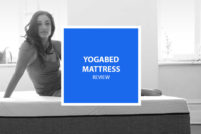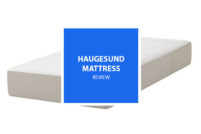Thinking about buying a new bed but unsure of how much money you should set aside for the purchase? Confused about the difference between innerspring, latex, and foam beds? If so, look no further.
Mattresses come in a wide range of prices, from less than $200 to over $5,000. How expensive a mattress is will depend on a range of factors, such as durability, materials, and height. Higher-priced beds (luxury mattresses) also tend to last much longer than cheaper ones.
This article will cover differences between each popular mattress type and what you can expect to pay for them, along with other factors that impact overall mattress cost.
Differences between Popular Mattress Types
Should you get an innerspring bed, memory foam, latex, or some other type of mattress? Let’s look closer at each of the most common mattress materials.
Innerspring Mattresses
Innerspring beds use a bed of coils for their main support, though the shape, quality, and design of the coils can vary widely. Considered the most traditional type of mattress, innerspring beds are covered by upholstery materials, like fiber or foam. Some innerspring beds have two layers of coils instead of just one.
These beds are best for people who carry some extra weight since the coils create a firm core that won’t sag as easily as other materials. An innerspring mattress can also work for someone who knows for sure they enjoy a bouncy bed with this type of firm support.
While these are often the most affordable types of mattresses out there, many sleepers will find them uncomfortable if they don’t have enough padding. This is one of the reasons why hybrid mattresses are gaining in popularity for people who enjoy the feel of innerspring coils but also want plush comfort in their bed. We’ll cover more on hybrid mattresses shortly.
Latex Mattresses
Latex is a supportive material that can relieve pressure, like memory foam, but it has a couple of distinct differences. Firstly, latex is a slightly bouncy material, rather than slow-responding, like memory foam. Latex can be made from either natural material (like tree sap) or with synthetic compounds.
Whether it’s made from natural materials or not, latex is a hypoallergenic material, as it is quite resistant to dust mites and mold, which is beneficial for people who have allergies.
Latex mattresses are also known to be durable and sleep cool since you sleep on top of the mattress rather than in it, as you do with memory foam. If you want a bouncy, cool mattress and are sensitive to allergens, latex could be your best bet.
Foam Mattresses
Memory foam is a viscoelastic material, meaning that it can change shape and go back to its original form afterward. Instead of having a bouncy feel, memory foam responds slowly to pressure. Highly soft and absorbent, memory foam mattresses conform to your body, distributing your weight evenly and possibly relieving aches and pains.
This material also comes with the benefit of absorbing motion. If you sleep with a pet or restless partner, memory foam will absorb the vibrations from their movements, helping you stay asleep.
Memory foam is known for sleeping hot since you sink into the material. Most modern mattress companies have found ways to combat this with cooling technology, though, such as cooling gel.
Memory foam is a durable material that will last quite a while, as well. Tempur-Pedic memory foam mattresses, for example, last for up to 10 years, according to customers. If you want a luxurious bed and know you enjoy the cradling feeling created by memory foam, this could be a good option for your next bed.
Hybrid Mattresses
Hybrid mattresses combine the support of coils and the plush comfort of latex or memory foam. These mattresses aren’t as bouncy as innerspring beds but are still easy to move around on and they do have some bounce to them. The latex or memory foam layers on top of the springs help to absorb motion, so you probably won’t be too disturbed when your partner moves at night.
If you sleep hot, a hybrid mattress could work well for you. They tend to sleep fairly cool because the coils in the mattress prevent the sleeper from sinking too far into the surface of the bed. Just keep in mind that hybrid beds are very heavy because they contain both coils and foam or latex, which can make them difficult to move.
Overall, this kind of bed should work well for someone who wants the firm support of coils, a responsive bed, and a bit of contouring pressure relief.
Air Mattresses
An air bed (also called an air mattress) is a bed that uses air chambers as the support system, rather than coil or foam layers. Permanent air beds can be used as the main mattress for your bedroom and tend to cost a lot, although there are also cheaper inflatable mattresses used for camping and outdoors.
If versatility is your main concern and you aren’t shopping for a main bedroom mattress, a cheap air bed could work for you. Budget camping air mattresses tend to cost less than innerspring, memory foam, latex, or hybrid beds and are easier to move. Some models can be used as a guest bed, or as a permanent mattress in your bedroom, in addition to being used outdoors.
One major advantage to an air mattress is that you can adjust the firmness level by adding more air to make it firmer and less to make it softer. This makes it more versatile than most other mattress types and can be helpful when you have different guests with varying preferences over.
Another benefit to air mattresses is that they won’t sag in the middle, like foam or coil beds can, and if they do, you can simply add more air.
How Much does Each Mattress Type Cost?
he materials used in a mattress will have the greatest impact on price, compared to other factors. We’ll cover what you can expect to pay for each type below:
- Innerspring: These tend to cost between $700 and $1,200, with an average price of about $950 for a Queen.
- Latex: Latex beds will cost between $1,500 and $2,500 on average, with the most common price being around $2,000 for a Queen.
- Memory foam: Memory foam beds often cost between $600 and $1,200, with an average price of $900 for a Queen.
- Hybrid: Hybrid beds usually run between $1,200 and $2,000, with an average price of about $1,650 for a Queen.
- Airbed: Air mattresses cost between $1,500 and $2,500 on average for a permanent model you can use in your bedroom. A Queen will likely cost around $2,250.

What Impacts the Cost of Each Mattress Type?
For each type of mattress, there are different factors that will impact price point. Below, we’ll go over each mattress type and cover some of the most common of these factors.
Innerspring Mattress Cost Factors
Durability: Expected lifespan and durability will play a key role in the price point of an innerspring bed. The cheapest options on the market will usually only last for three to five years, whereas more expensive models, with more durable coils, may last a few years longer.
Coil count: Fancier innerspring mattress models tend to have a higher coil count, although this doesn’t always determine how long a mattress will last. Higher coil counts can provide better support and contouring, so try to select a mattress with a coil count of at least 300 for a Full bed, 400 for a Queen, and 480 for a King.
Coil Gauge: Coil gauge refers to how thick each coil is in the mattress. High-gauge coils are thinner with a springier and softer feel, and low-gauge coils are thicker with firmer pushback and thus more durable.
Pocketed coils: Some innerspring manufacturers make their mattresses with pocketed coils. Wrapping each coil in fabric can reduce motion transfer and noise significantly, so this quality does usually drive up the price of innerspring beds.
Latex Mattress Cost Factors
Natural versus synthetic latex: How much a latex mattress will cost can depend on whether the manufacturer uses synthetic or natural latex materials. While natural latex is made from rubber trees, synthetic latex is manmade. Natural latex is more expensive to make, so you can expect to pay more for a mattress made with it.
Manufacturing process: The synthetic latex used in mattresses is made with either the Dunlop process or Talalay process. Dunlop latex is heavier and denser than Talalay latex, which makes it more suitable for support layers. The Talalay process is less dense, adds cushion, and typically costs more than Dunlop latex. Some latex mattresses use both Dunlop and Talalay latex.
Number of layers used: Latex beds can have a varying number of layers used in their construction, which will impact the overall price and comfort of the finished product. The thicker a mattress is, the more it tends to cost.
Memory Foam Mattress Cost Factors
Type of foam used: The type of foam used in a memory foam mattress is probably the biggest determiner when it comes to price. Polyfoam is a common material used in budget memory foam mattresses, but with the lower price tag comes a mattress that degrades quicker. Mattresses with special properties in their foam, such as cooling gel or copper-infusion, will cost more than basic foam beds.
Foam density: The density of the foam used in a mattress will impact how durable it is and therefore it also affects the price. The low-density foam used in many cheaper memory foam beds is less durable and tends to deteriorate faster. Denser, firmer foams are used in more expensive beds and tend to last longer.
Airflow: Some types of foam come in a convoluted (egg crate-shaped) design. This structure can promote airflow, helping the mattress sleep cooler, but may end up driving up the price of the bed.
Hybrid Mattress Cost Factors
Quality of foam or latex used: The type of foam or latex used in a hybrid mattress will end up impacting how much the bed costs. If the mattress uses foam with cooling technology, it may end up costing more. A hybrid that uses natural latex, instead of synthetic, might also end up costing more.
Number of layers: Hybrid beds can vary widely when it comes to the number of layers used in the mattress. Since beds with more layers require more materials and a more complex manufacturing process, they will cost more than thinner beds with fewer layers.
Quality of coils: Micro-coils are basically similar to ordinary mattress coils but much smaller. They’re made with high-gauge, flexible wire and increase the overall flexibility of a mattress, adding to the conforming ability of the bed. Since these are a relatively new feature, beds with micro-coils may end up costing more than beds without them.
Airbed Mattress Cost Factors
Remote controls: Most air mattresses today come with remote or manual controls that let you inflate or deflate your mattress according to your preference. Some can even be controlled via online apps but these are more expensive than beds that use manual controls.
Extra materials: If an air mattress comes with additional comfort materials like latex, memory foam, or a micro-coil system, they will cost more than beds without these features.
Mattress height: When it comes to airbeds, the price be related to the height of the mattress. If the bed is taller, it will often cost more, as will a bed that has more air chambers.
Other Factors that Impact Mattress Price
There are a number of other factors that may affect the cost of a mattress, regardless of the type of bed it is. Here are some additional things to consider when it comes to the final price of your bed:
Shipping costs: While many manufacturers will give you free delivery when you order a mattress for them, some will charge a shipping fee. If you live in offshore U.S. territories, Hawaii, or Alaska, you can definitely expect to pay some additional shipping costs. For manufacturers that don’t offer free shipping with their beds, you can expect to pay $100 or more.
Returns: If you end up returning your mattress, you might have to pay a fee. Most online mattress companies offer sleep trials that allow customers to test out their bed before deciding whether to keep it. A lot of these trials come with fees for shipping and handling, so make sure you check the fine print in the company policy before you buy.
White Glove delivery: A high percentage of mattress manufacturers offer a service called White Glove delivery. This includes in-home assembly of your new mattress and packaging waste removal. This can cost anywhere from $99 on up.
Foundations: Depending on whether you need to buy a mattress foundation and what type you select, this could add quite a bit to your final bed price. Most mattresses will have options for foundations under the same brand name and these can cost anywhere from $150 on up.
In most cases, an average sleeper should be able to get their mattress for less than $1,000, although some may have higher comfort needs or preferences. Before you buy, make sure you research not only the quality of materials used and user reviews, but also the company’s warranty, sleep trial period, and shipping costs.





